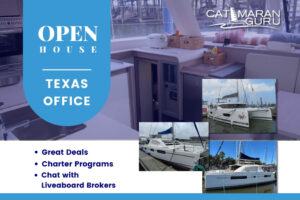If yacht phase-out with your yacht charter management program with a large charter company is imminent, this article is for you. These tips will help yacht owners who previously placed a new yacht into a with companies such as Dream Yacht Charter, Moorings, Horizon, or Sunsail. If you’re near the end of your contract with your charter company and you have decided to keep your boat, either for personal use or to sell her, you will want to prepare for a full inspection. Below is a list that will help you manage the phase-out process and determine the condition of your yacht. Most owners who follow this procedure receive a boat in very decent shape with most issues known.
1. Recommendations for Owners
- MOST IMPORTANT: Get personally involved in every detail of the process. Some owners hope their charter company will perform due diligence. That is possible, but only you, the owner, has a vested interest in seeing that the hand-over is complete.
- Have reasonable expectations. While you are probably not one of these type of owners, we have seen some who insisted their boat be in mint condition before hand-over. This is simply unreasonable and unfair to the charter company. This is where the concept of “fair wear and tear” applies. You cannot expect a shiny new boat back after frequent chartering during a 5-year contract. Remember that you were compensated for use of the boat during the charter contract term. Everything should be in working order, but you will not receive fresh upholstery and sails or a new engine unless they are beyond the “serviceable” status. Torn sails, non-working electronics, smoking exhaust, cracks in the rigging, and large blisters in the hull are not fairly worn and torn items, they are broken.
- Don’t be an abusive owner: Owners will get much more out of the charter company and of their relationship with the base personnel if they are friendly and develop a personal rapport with the base manager and the supervisors. In one word, be the owner celebrated by a round of drinks after work!
2. Organization Stage (Starts 1 Year Before Phase-Out)
- Prepare to go cruising! Once you have established your exact phase-out date in agreement with your charter company, schedule to take your boat on a 1-week cruise if you can, or at least for 3 or 4 days. Schedule that cruise to take place about 2 months before that phase-out date. Not less, because if you find some significant problems, the charter company will need time to fix them. But not more either: if there is too big a time lapse between the last haul-out and the Phase Out, you might have to haul the vessel again.
- Gather information: Be very organized about this, make a detailed list and take as many pictures as you can. Ask your charter company to give you the updated maintenance log of the boat and find out if there had been an accident/grounding causing a structural issue and check the repair. Obtain and read the charterers’ check-out or debriefing questionnaires if available to learn of any issues. Make sure all the boat manuals are on board, your phase-out manual and inventory lists are handy. If you intend to upgrade/add some items on your boat, things like a spinnaker & gear, storm sails, solar panels, life raft, EPIRB, radar, water maker, wind generator, etc.: Ask your charter company if they would agree to buy and install those on your boat during the phase-out work. This would be done at your expense, of course, but perhaps at a preferred cost? This could be a time and money saver.
- If your boat is in the Caribbean and you are bringing her home in the USA, make a list of the compliance items requested by the USCG and the US Authorities (Customs, taxes, etc.) in general. One of the main requirements is the connection of the holding tanks. Check up on insurance needs and options well in advance (6 months).
- Lastly and importantly, obtain the name of a good surveyor in your boat’s geographical area.
3. Start Scheduling the Phase-Out
- Say, 2 to 3 months before phase-out starts, work on booking a haul-out schedule. Although precise dates for a haul-out are difficult to schedule, a rough plan will help. For example, a bottom survey 6 months ahead of phase-out is not a good idea—too early—so get one organized about 3 months before phase-out, at the end of your cruise.
- Choose and line up the surveyor. If your boat is in the Caribbean, simply finding one (let alone a good one) in some areas can be a little bit problematic.
- Obviously, we highly recommend you make the haul-out and survey happen at the end of your sea trial cruise and in your presence.
- If you intend to keep your boat for personal use or will bring her back home, you will need to shop for a delivery company—unless you intend to sail her home yourself.
- If your boat is in the Caribbean, and you intend to ship out some extra equipment onto her, allow plenty of time. Caribbean Customs are not necessarily efficient or helpful.
4. The Phase-Out Stage
- The Sea-Trial: As suggested above, spend at least 3 or 4 days (1 week is best) cruising on your boat and go over everything yourself. Why do this, you might say, since the boat is going to be surveyed anyway? Well, it is always good and informative to conduct your own inspection for cosmetic and usability items.
- Take abundant notes and make a phase-out punch list which the surveyor and the base/maintenance manager will be able to work out of. That list, added to the survey, will become your main working document.
- Inventory the boat. Write down model and serial numbers of all equipment, especially if that equipment is not attached to the boat. Start this process as early as possible.
5. The Survey
If you have correctly programmed your phase-out procedure, you have scheduled the haul-out and survey at the end of your cruise or shortly thereafter. Needless to say, make your best efforts to be present for this. If you cannot, surveyors usually take lots of pictures so photos of problem areas can easily be sent to you for your own inspection. A thorough survey takes the whole day and is composed of the following:
- Complete hull inspection during haul-out looking for possible blisters, delamination, and structural issues if the boat went aground.
- Complete exterior inspection including deck flex, leaks, mast, rigging and sails, etc.
- Complete interior inspection with test of all electric panels and systems, refrigeration system, detection of potential leaks, etc. Complete engine run-up and check-up (starting with a cold engine) with sea trial for verification of gear engagement, misalignment or vibration of the propeller shaft, etc. NOTE: Your boat surveyor may not necessarily be an engine/diesel surveyor. If so, it is a good idea to hire a specialized engine surveyor. It is well worth the cost.
6. After the Survey
At this stage, armed with the survey and your own list, you probably will have to negotiate with your charter company to determine the items that will be fixed at their expense. This is where your Management Contract and the concept of “fair wear and tear” come into play. If your contract is well defined in this area, part of this will be a no-brainer and the Company should fix obvious items without arguing: Hull delamination, torn sails or bimini, cracks in the rigging, broken electronics, leaks, malfunctioning refrigeration, missing inventory items, etc.
However, some other items will be in a gray area. For example, how do you define “fair wear and tear” on upholstery, cushions, sails, sheets and halyards, woodwork, and more generally in all cosmetic items? It’s not easy thus it becomes a matter of negotiation and fairness on behalf of the charter company and its representative, the Base Manager.
After both parties finally agree upon the “Big List”, the idea is for you to do a lot of follow-up. For example, call the Base Manager (or whoever is in charge of your phase-out) once a week and discuss the progress. Finally, when all this is done, we recommend that you plan at least a week to “accept” the boat to check everything, familiarize yourself again with all the systems and get the boat “passage ready”.
7. Yacht Phase-Out Punch List
This is in no way a comprehensive list, but can be used by the owner as a guideline for a pre-inspection before the professional survey. Besides, this list does NOT address inventory items which must be checked separately. The surveyor will only inventory safety items.
On Deck
- Windlass functioning properly both ways. Connections on remote control sticky?
- Chain rollers OK/bent
- Anchor chains (primary and secondary) in good shape/rusted
- Leaks from the anchor well to the boat bilge thru the bulkhead
- Flex on the deck
- Main hoisting easy, or very hard
- Mainsail furling system (if applicable) working smoothly
- Foresail furling system working smoothly, or very hard
- Reefing system working
- Lazy jacks OK
- Sails torn, stretched
- Leak at the base of the mast
- Winches working smoothly
- Stanchions and lifelines, swim ladders, OK
- All halyards, sheets, docking lines in decent shape
- Foresail sheets correct size
- Hatches working properly? Any leaks?
- All deck electronics: Loch speedo, wind indicator, Auto Pilot, GPS repeater, etc… in working order?
- All deck lights, navigation lights working
- Cockpit table opening properly
- Shore power working when connected? Battery charger working
- Deck shower working? Leaking?
Engine
- Will be surveyed but: Starting fine? Overheating after 2 hours of use? Black smoke? Oil pressure check
- Engine maintenance log checked. Try to detect repeating problems.
- Transmission: Fwd/Astern control lever working fine?
Cosmetic Items
- Bimini / dodger: need stitching? Color very faded? Zippers working?
- Mail sail cover torn?
- Nicks and scratches on the hulls
- Brightwork in decent shape?
- Cushions decent?
Under Water
- Zinc collar at the prop shaft
- Blisters, osmosis on hull and/or rudder (survey item)
- Rigging (MUST be inspected aloft by a Surveyor or professional rigger)
- Check for any cracks just forward of the keel
Down Below
- Find explanations for any leaks or smells
- Inspect the bilges looking for dry conditions with no indications of exposure to black water
- Do heads, showers, and drains work properly?
- Presence of connection holding tanks (required if boat brought to the US)
- Electric panel in working order?
- Inverter (if applicable) working?
- All electronics in working order: VHF, GPS, Radio Cassette/CD tuner
- Stove and gas connections
- Hatches working properly? Any leaks?
- Upholstery/cushions/linen decent?
- Original boat inventory entirely checked?
- Upholstery/cushions/linen decent?
- Original boat inventory entirely checked?
Other
- General aspect
- Dinghy (if applicable): air leaks?Anchor with rope
- Outboard starting OK?
- Paddles in dinghy
- Anchor with rope
- Air pump
- Gas tank






